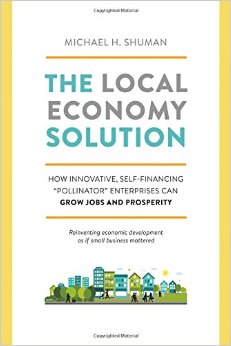
 Fifteen years ago, Wal-Mart and Home Depot rolled into the Rutland-sized town of Midland, Ontario. A 20-year-old man who had built the website for his parents’ paint store decided to help locally owned businesses compete with the big-box giants.
Fifteen years ago, Wal-Mart and Home Depot rolled into the Rutland-sized town of Midland, Ontario. A 20-year-old man who had built the website for his parents’ paint store decided to help locally owned businesses compete with the big-box giants.
The result was ShopMidland. It’s a professionally produced website with photos and descriptions of local business vendors and their services. Today, the 1,500 participating (and fee-paying) businesses can modify their content online and offer gift certificates and weekly deals. Colin Pape, the originator, has now franchised the idea to other local entrepreneurs, who have created 25 similar sites across Canada and 15 in California.
In Washington, D.C., a firm called Main Street Genome is analyzing the purchasing patterns of 300 independent restaurants. Its technology-intense program reveals how the restaurants can shave as much as 15 percent off their costs by smarter purchasing and better cash management. MSG is going nationwide this year.
In Bellingham, Washington, a group called Sustainable Connections has achieved spectacular success with its Local First business marketing program. A San Francisco credit union has generated new revenue for local businesses with its BernalBucks neighborhood business debit card.
In Ann Arbor, Michigan, a successful deli named Zingerman’s has created a family of independently owned but coordinated enterprises – creamery, bakery, coffee roaster, candy making, produce farm, roadhouse restaurant, online sales – collectively named the Zingerman’s Community of Business. ZCoB operates an entrepreneurship training program for employees who have visions for new businesses of their own.
These are only five of 28 grassroots efforts to stimulate local economic activity described in Michael Shuman’s latest book, “The Local Economy Solution: How innovative self-financing ‘pollinator’ enterprises can grow jobs and prosperity,” just published by Chelsea Green in White River Junction.
The common ingredient is that all of the pollinators are locally grounded, and succeed by building local support in pursuit of the shared goal of revitalizing the local economy.
The first thing to understand, Shuman says, is that the traditional “economic development” model of chasing after large companies with huge taxpayer subsidy deals is absolutely the wrong way to revitalize a crippled or stagnant local economy. Indeed, he says, “economic development today is creating almost no new jobs whatsoever.” In support of that conclusion he methodically dissects and refutes the “eight myths of [conventional] economic development.”
There is another far more promising path. “A growing number of small, private businesses are … facilitating local planning and placemaking, nurturing local entrepreneurs, helping local consumers buy local and local investors finance local business. And most remarkably, by charging clients reasonable fees for their services, they are able to cover their costs.”
These functions are performed by what Shuman calls “pollinators.” These come in five varieties: planning, purchasing, people, partnership and purse. For each, Shuman offers insightful descriptions of their workings, drawn from site visits throughout the U.S., Canada and even Australia. The common ingredient is that all of the pollinators are locally grounded, and succeed by building local support in pursuit of the shared goal of revitalizing the local economy.
Shuman is convincing in his belief that “if we replicated the two dozen models described in this book, economic development ultimately could be done by the private sector at virtually zero cost to the public.”
Spearheading the growing national movement toward local business generation is the Business Alliance for Local Living Economies (BALLE, which held its annual meeting in Burlington in 2006), the American Independent Business Alliance, and the Schumacher Center for a New Economy (where Shuman is heading its Localpedia project).
How can these innovative local businesses be financed? Shuman addressed that question in his 2012 book “Local Dollars, Local Sense” (also published by Chelsea Green). The techniques often require state government to relax long-outdated regulations that “protect” people from investing in local enterprises.
Last year, the Vermont legislature directed Financial Regulation Commissioner Susan Donegan to prepare a report on “crowdfunding,” that is, expanding the market for financial support of local enterprises. Her report appeared in January, and a new securities rule entitled “Exemption for Small Business” is working its way through the promulgation process.
For anyone still in thrall to showering subsidies on outside corporations in the name of “economic development,” “The Local Economy Solution” will be a game changer. Anyone eager to generate new economic life in their community or region will find this book to be a treasure chest of innovative ideas, invaluable experiences, and high motivation.
- All
- Agriculture
- Arts & Culture
- Book Reviews
- Civil Liberties
- Decentralism & The Vermont Tradition
- Education
- Empire and Overshoot
- Environment
- Featured Content
- Features
- Film Reviews
- Finance & Money
- Food
- Fuel & Energy
- Global Problems, Local Solutions
- Homestead Security
- Information & Media
- Interviews
- Military
- Most Likely to Secede
- Music Reviews
- Politics
- Resilience & Community
- Sovereignty & Secession
- Uncategorized
- Vermont Commons









You must be logged in to post a comment.